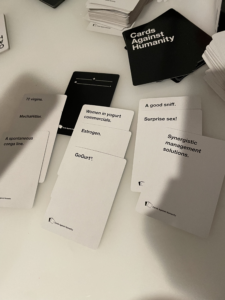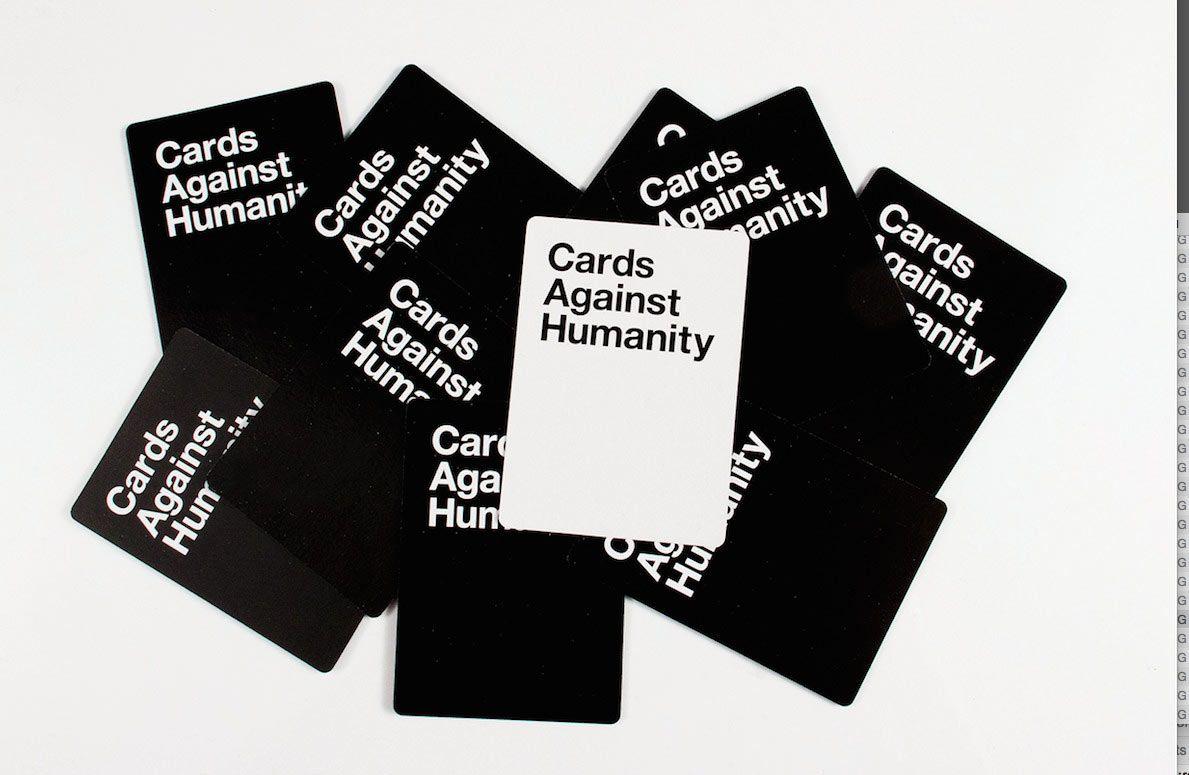Game Information:
Name: Cards Against Humanity
Creator: Max Temkin and friends from Highland Park High School
Platform: Card game with some adaptations online like Playingcards.io
Target Audience: 3-20+ players ages 17+
In Cards Against Humanity (CAH), players compete against each other to earn black cards (scenario cards) or points by the end of the game. These cards indicate that a person had won a given round by being the funniest. Each round, a player takes a black card and reads it outloud to the group. The rest of the players put down white cards to fill-in-the-blank of the black card, and the person that read it out judges based on humor and picks a winner for the round. This game was designed with dark humor and social commentary in mind, where they themselves state that it’s a “party game for horrible people”. By leveraging anonymity and dynamics of judgement, Cards Against Humanity cultivates close group interactions, enriching social engagement through humor that plays on existing relationships and fosters intimate interactions. Players are encouraged to cater to whoever reads a black card and be creative with their white cards to be the ‘funniest’, prompting players to cultivate strong connections to one another and engage in deeper social interactions.
In my playthrough of Cards Against Humanity, I noticed the anonymity mechanic influences judging significantly, encouraging a stress-free environment where the group can freely express themselves however through the white cards. Keeping people’s answers anonymous prevents personal judgment on a singular response while still creating a carefree, fun environment. For example, one of our rounds involved controversial combinations of cards that could be offensive to individuals, but due to the anonymity this protects players from being judged personally for their answers which led to shocking and memorable moments. The design of the game encourages group dynamics like these, breaking the ice and allowing creative expression in a way that deepens levels of connections for players. However, the setting that this game is played heavily depends on the existing relationships of players; if the players are strangers then cards may be played as an exploration of humor in the group without compromising one’s identity, but if players are friends then answers cater to existing notions of the groups’ dynamics.

While Cards Against Humanity maintains forms of anonymity, the content of the game itself may be insulting to some. The limits of this game are based on the leniency of the groups’ humor, and players with stark contrasts in humor may have issues interacting with one another. Therefore, the theme of the cards, which there are many of, is an important choice for players to make before actually playing the game. The game could benefit from more customizable card decks to ensure all players feel comfortable and engaged. Knowing the audience is crucial and even more important for the judging mechanic, since each player’s humor is different. With more control over the content and levels of intensity of the game, the game could reach a wider audience. In my playthrough, we were all friends and comfortable with dark humor, so this led to some particularly funny (to us, at least) and shocking moments. But, I would argue that this is the premise of the game and how CAH differentiates itself from other similar games like Apples to Apples. The adult focused themes stand out from competitors and making more “edgy” content draws a different crowd, who is more likely aware of the types of cards in the deck. Also, this game separates itself from a “getting to know you” game as the prompt isn’t based on the players, but is instead focused on humor of the players.
Cards Against Humanity aligns with fellowship and discovery from the types of fun we’ve discussed before. The game is centered around discovering one anothers humor preferences and building answers based on these assumptions/knowledge. The longer the game progresses the more the group grows in understanding each other and becoming more aware of what makes something funny. In a similar way, this created bonding moments for people with shared humor types and a sense of fellowship in the group as we debated which card was the funniest.
All in all, Cards Against Humanity showcases how a card game can foster social interaction directly through humor and allows players to discover one another through their card deck. Utilizing anonymity and judgement creates for shocking, interesting and fun interactions that push the boundaries of humor. Due to the intensity of the games’ themes, it allows for lighthearted discussion and laughter which makes the game a powerful method for discovering group dynamics and stand out from other similar games. I’ve always had a great time playing this game, and since my humor is pretty lenient, it has led to moments where I’ve closely bonded with my friends and built relationships through humor. I’ve learned more about my friends’ preferences, boundaries and personality through CAH and it’s been a great way to showcase my own as well.



